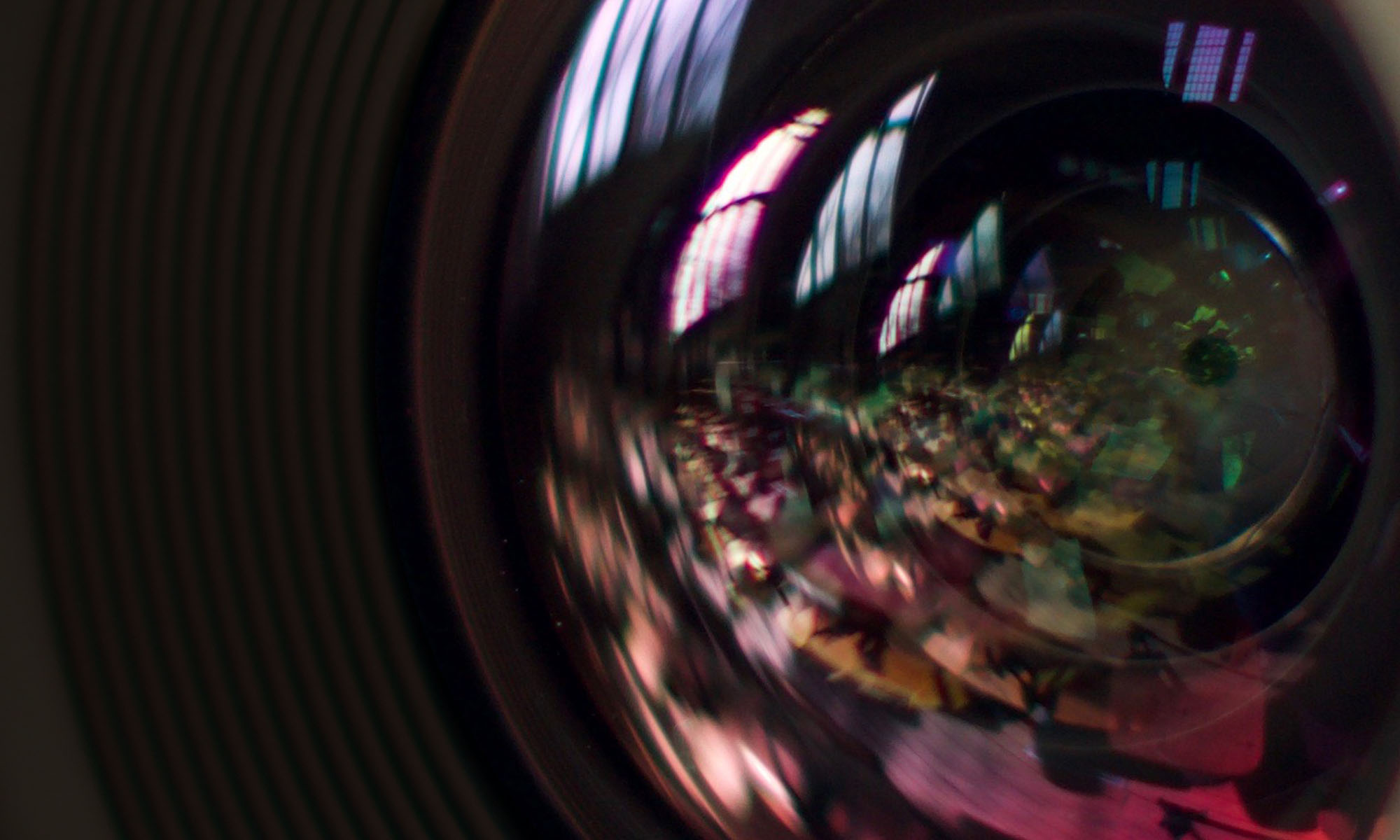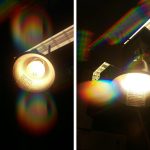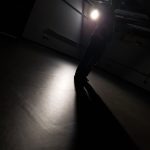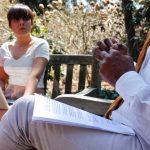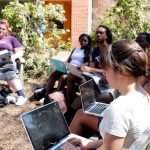Yash Huilgol, WWS ‘18 – 1st Place
Chalk Pollock
Often, Princeton students neglect what happens in a class after it ends. Often, the chalked writing is erased, leaving behind a path of white streaks. On one particular day my Freshman year, I was walking by Fisher Hall, the old economics building and discovered a pattern that vaguely reminded me of a Pollock painting. I was intrigued by the seemingly haphazard pattern formed by important equations that form the fundamental basis for inequality, finance, and supply/demand. I was walking by the new Julis-Romo- Rabinowitz Building recently, and took this photo. It seemed a perfect capture of my feelings my freshman year.
It is easy to forget what happens in a classroom on a day to day basis, and after being intrigued for the last couple of years by the fact that erasers never truly erase, how do we start to unjumble what has been written? How can we integrate things together? These are the questions that I think about.
Cody Kohn, EEB ‘19 – 2nd Place
Chicharrón
As a pre-vet student (and hopeful veterinary surgeon), I strangely look forward to each dissection in EEB 314 Comparative Physiology. My lab partner and I get very comfortable with our specimens, and we often name them. We spend about 2 weeks with each animal before we are tested on their physiology, and then they are laid to rest. It is important to get to lab first so that you have first pick of your new pet. So far, we have had the pleasure of working with Cat the Dogfish Shark, Barbara the Sheep, and Chicharrón the Piglet. They have helped us learn the physiology and anatomy of a wide variety of animals. We know everything about their bodies. Sometimes we wonder what their lives would have been like if they had been born, but we usually find some sort of deformity that would have killed them instantly after birth anyway. At the end of this week, we will be saying goodbye to Chicharrón. May he rest in peace.
David Friedman ‘20 – 3rd Place
Loveseat
Summer, 2014. Taking momentary refuge from a sudden, unexpected rainstorm, our Orange Key tour group clambers into McCosh 50. The wooden floor planks creak harmoniously as I, just a starry-eyed high school sophomore, tiptoe through the grandiose lecture hall. I wonder what kinds of captivating lectures are held here on a daily basis—astrophysics, or human rights, maybe?—and what kinds of eccentric, inhumanly intelligent students fill the room during classtime. Sinking into an uncomfortably stiff wooden seat, I wonder what it’d be like if I were at Princeton. Sitting there, I realize: I really love this place.
Spring, 2017. Almost three years later, I find myself seated in that exact same lecture hall, McCosh 50, every Tuesday and Thursday afternoon for my microeconomics lectures. Chalk flies across the blackboard at the front of the hall as my professor constructs precise & complex graphs and defines obscure technical terms. Submerged in a sea of students, I hurriedly scribble notes as the professor moves onto the next topic for the lecture. At times, I’m discouraged by the rigor of the concepts we cover, or the pace at which we fly through the material. But always, I feel the uncomfortably stiff wooden seat beneath me. I think back to my dreams of being a Princeton student, and of how much I actually enjoy the challenges Princeton throws at me. Sitting there, I realize: I really love this place.
Kara Bressler, Computer Science ‘19 – Honorable Mention
Resistor
Lighting is a constant in my life. Taken during physics lab, this shows the first circuit I ever created – lighting up a light bulb resistor!
Andie Ayala ‘19 – Honorable Mention
The Words Between the Shadows
This photo was taken during the Testimonies from Refugees and Workers panel during the Seeking Refuge: Faith Based Approaches to Migration Conference. In this panel, reverends, community organizers, politicians, professors and administrators spoke. To have such thoughtful and vulnerable conversation very much transformed the space, and created a sense of connection and wonder between all in the room.
Additional Submissions in Random Order
Olutola Ebunlomo, WWS ‘17
Treehouse
This is for all the days I couldn’t choose between sunshine and passing chemistry…
Juliana Wu, Computer Science ‘17
JW, past artistic director of Old Nassoul, relaxes between teaching in their rehearsal space – an intrapeer classroom.
Every week, members of Soul/R&B acapella group Old Nassoul dedicate hours of precious time within their rehearsal space. I was struck in particular by the most vibrant, welcoming, and eclectic environment I’ve ever seen at Princeton – bright orange walls, a crazy couch, and musical memorabilia for days. Visually it presents influences and instruments essential to the group’s process, but the striking warmth and energy of the room are a direct result of the efforts of members to personalize the room to the unique Old Nassoul brand. The room isn’t just a space for rehearsal, but serves as an intra-peer classroom in which members not only learn new music but teach each other how to grow, and contribute to and participate in their group identity. The Old Nassoul room is a home for expression, brotherhood, and new opportunities.
Morlan Osgood, Computer Science ‘20
Calculus on the Weekend
This is the classroom where I attended my first official class as a freshman. I was shocked at the small size and modern style. To me, this symbolizes the true start of my academic journey at Princeton.
Yash Huilgol, WWS ‘18
Learning with Spires
Classrooms are inspiring and enriching based on the content that they teach, but after walking through the Julis-Romo-Rabinowitz building on a foggy evening, I was shocked to see the beauty of Princeton’s old gothic spires of the Chapel and Firestone Library, like a tapestry draped along the side of the classroom. The luminary speakers on this panel must have been as much an inspiration for the colloquium hosted there as the classroom setting.
Alice Tang, Computer Science ‘18
An exploration of light using diffraction grating, with different patterns arising from the different emission spectra of incandescent light bulbs and fluorescent ceiling lights.
I feel most excited by those moments in which my studies have granted me new perspectives and insights on the world around me. This set seems to capture this sentiment in a literal sense, yet opens the doors to the fantastical. Through the diffraction grating, we see into another world—just a dimension away from our own.
Alice Tang, Computer Science ‘18
Nested beakers sprout into a rose.
Scientist becomes “God” in a moment of Frankensteinian realization, appearing to recreate life.
As scientists, we often see lab paraphernalia as a means to an end—the tools that enable our research. This is indeed so, yet these very tools may be recast to artistic effect; I noticed once while storing beakers that the resulting nested figure reminded me of a rose. In using tools that enable us to explore the elements of life, I felt as though I had created it in some uncanny way.
Alice Tang, Computer Science ‘18
Nymphal oncopeltus fasciatus subjected to the human gaze, distanced yet augmented through glass.
We often think of the classroom as the rectangular box—carpeted or tiled, flourished with a board, colonized by seats. For me, much of the learning process has occurred in laboratory environments. In the process, I have had the chance to be immersed into worlds of various scales, from the millimeter down to the nanometer scale. One day, I was looking through the microscope at oncopeltus nymphs, normally only a couple millimeters in length. The microscope opened up a world of color and detail not easily appreciated by the unassisted eye. This particular collage occurred when it dawned on me to photograph through the eyepiece—a process that required considerations of focal length and angle.
Alice Tang, Computer Science ‘18
Embodied Computation.
In this lighting workshop, we explored how light chisels out form, affecting emotion and perception. I am reminded of how at Princeton, we have opportunities to mold our identities, sometimes seemingly so ephemeral and constructed. How we see and project ourselves may change under different lumination.
Kara Bressler, Computer Science ‘19
Exposure
I love lighting, and when I get to work with long exposure in physics lab, I can ask for nothing else.
Kara Bressler, Computer Science ‘19
Swivel
This abstract is that of light’s reflection on a chair in McCosh during precept. This depicts what I look forward to in Princeton classrooms – light streaming in through windows. Ah. Gotta love it.
Kara Bressler, Computer Science ‘19
West Virginia
The outdoors is my classroom. In my field research in West Virginia, I learned so much about what I value in my interactions with others, with nature.
Vivian Chang ‘19
The Outdoor Classroom
This is the view on my walk every day from Lakeside Apartments to campus. As a graduate student, I have lived and learned in a few institutions of learning before Princeton. Being here I have learned about public policy, economics, and a little bit of campus activism. But some of the most important things I’ve learned, and that I still need to learn every day, are how to relax. How to see beauty without having to capture it. To let it flow into me and past me. To lift my head up from my phone and let the words of nature linger more than any words on paper or screen.
Devina Singh, Computer Science ‘19
Learning Introductory Microeconomics in a Castle
It’s moments like these – sitting in McCosh 50, learning introductory microeconomics from one of the most influentially economists in the world, that remind me of how lucky I am to be at a school like Princeton. “Here we are taught by men and Gothic towers Democracy and Faith and Righteousness And love of unseen things that do not die ” – inscribed under McCosh Hall.
Pilar Bennett, EEB ‘17
Sunset silhouettes on the Savanna
I am a tree hugger—I chose Ecology and Evolutionary Biology as my major to learn about the complex life underlying the beauty of our natural world. I take pride in my ecology concentration, and I value it even more after having layered in minors in Urban Studies and Environmental Studies so I could cover the spectrum of human-wildlife interactions. To really delve into and satisfy my desire to experience hands-on ecology and conservation field work, I took an opportunity to study abroad in Kenya for a portion of this spring semester. I am so thankful that I did—my team’s work with the Maasai community, whose lives are impacted by wildlife daily, opened my eyes to the importance of making conservation initiatives human-centric. This particular image was taken at the close of a long day of field work at Ol Pejeta Conservancy in Laikipia County.
Karissa Lowe ‘20
Learn for You
Within the classrooms at Princeton and beyond you learn much more than just the lecture material.
Karissa Lowe ‘20
With a pencil, I can grow
Taken in the well-known lecture hall, McCosh 50, a plant stands tall and sturdy using a pencil to support its growth.
Karissa Lowe ‘20
With a pencil, I can grow
The sun illuminates a small plant inside the large lecture hall of McCosh. So much happens both inside and outside of the classrooms at Princeton, and bringing these experiences together is what creates amazing growth.
Karissa Lowe ‘20
Teach not how to grow, but why to grow (2)
The sun illuminates a small plant inside the large lecture hall of McCosh. So much happens both inside and outside of the classrooms at Princeton, and bringing these experiences together is what creates amazing growth.
Jennie Yang, EEB ‘20
ASL Storytime
I was sitting in the Green Hall 0-S-9 classroom for my American Sign Language beginner class. Class was over, and my professor was retelling a story to those who had missed it. He is pictured signing “but” in ASL, which looks very similar to “different”—one of our vocabulary words. The story was about a deaf man who drove his car to a railroad crossing. He waited and waited, but the gates would not rise, so he got out of his car and walked until he met another person. He tried to sign to the person that the gates would not rise by waving his index fingers much like my professor is doing in the picture. The person did not understand him for quite a while until he brought the person to the railroad crossing. The person realized what he meant and lifted the gates. The man was finally able to drive through. The classroom experience is very powerful; there was a talk on sign language humor earlier this year that I wish I could have attended! There is a difference between learning vocabulary and seeing signs in action during ASL storytime.
Jennie Yang, EEB ‘20
ASL: It’s a Language
Seen in Green Hall 0-S-9 at Princeton: A deaf professor from Kean University signing “stand” in American Sign Language during a vocabulary quiz. Two not-for-credit ASL classes were offered by Princeton University American Sign Language Club and sponsored by the Office of the Dean of Undergraduate Students this semester: a beginner and an intermediate class. Every Thursday from 6:00-7:20pm, I have been running from choir rehearsal to attend the beginner class. 90 students signed up for it, and I was initially not one of the people lucky enough to be randomly selected, but someone dropped the class, so I was in! I’m extremely grateful to PUASL and to Princeton for the opportunities it provides—I never thought I would be learning ASL in college! In elementary school, I learned how to fingerspell the alphabet. What I didn’t know then was that I had only been taught the American Manual Alphabet, one component of American Sign Language, and that there is no single, global ‘Sign Language.’ Each sign language encompasses much more than simple fingerspelling; signs consist of handshape, movement, location, and orientation, and can even include non-manual markers like facial expressions. The caption says it all—ASL: it’s a language.
Jennie Yang, EEB ‘20
Hairy Situation
Overheard in Schultz 105: “I never thought I’d be using nail polish to glue an eyebrow hair onto a toothpick. Come to think of it, I never thought I’d be using an eyebrow hair to touch a worm.” On this Wednesday in MOL214 lab, we were using a stereo dissection microscope to view C. elegans on an agar plate, observing their movement. We had already performed a plate tap test, in which we lifted the plate and dropped it to see if the worms would react (they moved faster!). We were now performing a touch sensitivity test. My lab partner Christina had plucked a hair off her eyebrow, and we had glued it to the end of a toothpick (using nail polish!) and rinsed it with ethanol. Christina is pictured gently passing the hair across the body of a C. elegans worm and looking at it under the dissecting microscope. She noticed that the worms undulated in the opposite direction after she touched them. The experiment, classroom, all of it!, really speaks to the incredibility of the Princeton experience. This was the first time many of us observed C. elegans under a microscope, and it was, indeed, a hairy situation.
Jennie Yang, EEB ‘20
Busy (Mol) Bio Break
I am taking MOL214: Introduction to Cellular and Molecular Biology, so I have a three-hour laboratory section every Wednesday. This particular Wednesday was the second one after spring break. There was a tangible feeling in the air that March did not in fact go out like a lamb—I remember messaging my friend the first day of April, “I didn’t realize spring semester would be so much busier (classes are picking up and I have an exam in under two weeks ??).” On this day in lab, I was sitting in my chair and wearing gloves and safety glasses much like my lab partner Christina who is pictured. We were waiting for our electrophoresis gel to stain for 10 minutes, and I looked around and noticed that other groups had placed their staining trays in the horizontal shakers and were also waiting . . . but it was a busy wait. Some students were using their laptops to work on other assignments; others were writing down procedure notes and observations in their lab notebooks. Christina was looking ahead at the final steps of the protocol, and my lab TA (Betsy!) was helping another group. It was, for sure, a busy (mol) bio break.
Jennie Yang, EEB ‘20
Sea of Chairs
I am currently a freshman and prospective Ecology and Evolutionary Biology major with an interest in Linguistics, so McCosh 50 is special to me for two reasons. I remember the first day of classes—I was wearing a bright orange Princeton shirt and walking from Forbes College (or getting lost and burying my head in my phone using the Princeton interactive campus map) to McCosh Hall. I grabbed a free bagel from USG and got my “First Day of School” photo taken by ODUS. I met someone at the table who, like me, was enrolled in LIN201: Introduction to Linguistics, so with 5 minutes to spare, I followed them up the stairs and into McCosh 50. I was a bit overwhelmed by the size of the classroom; there were already people seated, so I ducked into a front row seat and pulled out a red notebook from my backpack. Professor Fellbaum’s lecture—my first one at Princeton—was wonderful! A month and a half later, I took my first EEB midterm in this same classroom. I sat in the front row up in the balcony and felt so nervous. The one thing that stayed constant was the sea of chairs.
Joshua Umansky-Castro, MAE ‘17
The Wall of Death
Course instructors, TAs, and students alike gather round as our robot Marvin attempts the largest challenge of them all: traversing the wall. Though not successful on this particular attempt, with some small tweaks and a bit of duct tape we were the first and only group to meet the milestone (Note: we will be sure to replace all duct tape with more secure means for the upcoming drop test.) Based in the MAE machine shop, this course in Mechanical Design teaches students manufacturing techniques as well as invaluable lessons in vehicle design and project management. As a senior, I loved having the opportunity to get a real hands on experience before entering the industry.
Joshua Umansky-Castro, MAE ‘17
“Let’s see those trains move.”
Professor Littman asks questions about final projects as students present their car sorting algorithm. Appropriately nicknamed “Trains,” this classic course on microprocessors provides MAE seniors with the electronics background necessary for future interdisciplinary engineering projects. While moving trains along a track may seem like a straightforward goal, this demonstration is a testament to the weeks of design, construction, testing, and frequent bewilderment of trying to diagnose electrical signal issues. As a mechanical engineer who loves tangible concepts, this course took me beyond my comfort zone as I developed a strong understanding of computer architecture and circuit design.
Joshua Umansky-Castro, MAE ‘17
Contemplative Debugging
Students debug their project board as the presentation deadline approaches. Appropriately nicknamed “Trains,” Prof. Littman’s classic course on microprocessors provides MAE seniors with the electronics background necessary for future interdisciplinary engineering projects. While colorful Lego blocks add aesthetic and functionality to the various mechanisms on the train track, their bright and cheery colors are a strong contrast to the bewilderment of trying to diagnose electrical signal issues. As a mechanical engineer who loves tangible concepts, this course took me beyond my comfort zone as I developed a strong understanding of computer architecture and circuit design.
Joshua Umansky-Castro, MAE ‘17
“Go Marvin, Go!”
The team watches as our robot completes the first milestone of the semester: tracking a light to autonomously drive towards the basket. Based in the MAE machine shop, this course in Mechanical Design teaches students manufacturing techniques as well as invaluable lessons in vehicle design and project management. As a senior, I loved having the opportunity to get a real hands on experience before entering the industry.
Joshua Umansky-Castro, MAE ‘17
“Go Marvin, Go!” (2)
The team watches as our robot completes the first milestone of the semester: tracking a light to autonomously drive towards the basket. Based in the MAE machine shop, this course in Mechanical Design teaches students manufacturing techniques as well as invaluable lessons in vehicle design and project management. As a senior, I loved having the opportunity to get a real hands on experience before entering the industry.
